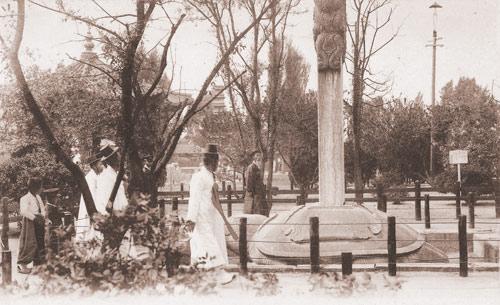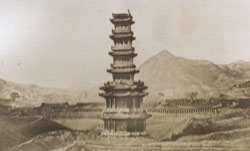Words BY Robert Neff
Photos from the Robert Neff collection

The six-century old Wongaksa Pagoda lay in ruins until Westerners in Seoul began to take an interest in it.
One of the most interesting but least known historic sites in Seoul is Tapgol Park (탑골공원), also known as Pagoda Park. Located in the Jongno area between Jonggak and Jongno 3-ga Stations, the park’s history provides fascinating parallels with the larger history of Korea.
The centerpiece and namesake of the park is Wongaksa (원각사) Pagoda (National Treasure #2), which was built in the 1460s. One of the earliest Western descriptions of this pagoda was made by Percival Lowell in the winter of 1883/1884. Lowell describes the pagoda as being “nearly in the heart of the city” and hidden by the roofs of the Korean homes that surrounded it. Since he could only catch fleeting glimpses of the pagoda as he walked down the main street, his curiosity was piqued. He was determined to view what he deemed to be the only pagoda in Seoul.
He made his way through a maze of alleys and small courtyards and eventually found himself in “an ill-kept little garden in the midst of which rose the deserted solitary pagoda.” Lowell, one of the earliest amateur photographers in Korea, wanted to snap a picture of the pagoda. After obtaining permission from the owner of a nearby house, he climbed up onto its roof.
This was a serious social faux pas. During the Joseon period, it was forbidden for men to look over the wall into their neighbor’s courtyard for fear of seeing his neighbor’s wife or daughters. Those who violated this law were often beaten and imprisoned.
Lowell writes:
“I have reason to believe that the proprietor neglected to notify his neighbors of my intention, as I caught a woman in an adjoining back-yard in the act of hanging out some washing. Unfortunately, she did not tarry long enough for me to photograph her, but dodged under shelter again with virtuous rapidity.”
Although Lowell’s picture of the pagoda was a little blurry, he was quite pleased with it:
“The white granite had become slightly discolored with age, but enough of its former purity remained to bring it into effective contrast with the somber gray of the houses.”

But Lowell’s initial elation at photographing the pagoda contrasts greatly with his mood when he writes, “The garden in which it stood was a shabby, sad-looking little hole, not above twenty feet square; and the whole place, pagoda and all, looked—as in truth it was—utterly forgotten.”
For the most part it had indeed been forgotten, at least by the citizens of Seoul. Over the next two decades, many of the early foreigners visited the pagoda and its “sad-looking” little garden, but it wasn’t until 1897 that anyone really took an interest in it. It was then that McLeavy Brown, a Scotch-Irish barrister employed by the Korean government as commissioner of Korean customs and financial advisor, had the vision to make the first modern park in Seoul. He chose to build the park around the pagoda.
By 1903, the homes around the pagoda had been cleared and a little enclosure was built around the pagoda to protect it. Brown wanted to repair the pagoda by returning the top three stories lying on the ground (removed in the late 16th century) back to their original position, but the Korean “court necromancers” vehemently opposed his idea, claiming that “great misfortunes would befall the country if the top was replaced.” Brown was forced to concede.
Strangely enough, in 1947, US Army engineers brought in a crane and hoisted the three stories back to their rightful place, probably as part of an effort to revitalize Korea following its liberation from Japan’s colonial rule. Just as the soothsayers had predicted, “great misfortune” soon followed. On June 25th, 1950, the communist forces of North Korea invaded, thus beginning the Korean War.



